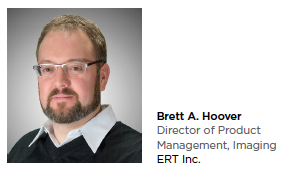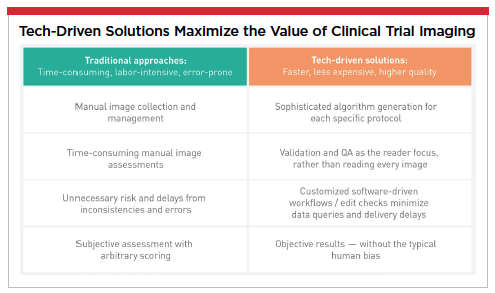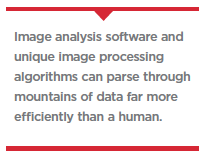 Technology and innovation are reshaping clinical trials. Nowhere is this more evident than in the use of imaging in drug and device research. Over the last 10 years imaging has evolved from mostly qualitative assessments to more and more truly quantitative measurements. This is driven by the increasing need to visually demonstrate safety and efficacy to a range of stakeholders, including the FDA, patients, payers, and providers.
Technology and innovation are reshaping clinical trials. Nowhere is this more evident than in the use of imaging in drug and device research. Over the last 10 years imaging has evolved from mostly qualitative assessments to more and more truly quantitative measurements. This is driven by the increasing need to visually demonstrate safety and efficacy to a range of stakeholders, including the FDA, patients, payers, and providers.
The result has been an approximate 700% increase in the number of clinical trials implementing imaging. This dramatic increase isn’t just related to the use of more advanced imaging such as MRI versus X-ray, but also the use of software and technology capable of deriving more insightful data from the images themselves.
Another growth driver for trial imaging is its ability to help sponsors differentiate  new drugs/devices from the current standard of care. Imaging, along with bespoke software built around artificial intelligence (AI) married with and validated by clinical expertise, provides a path to prove novel safety and efficacy endpoints.
new drugs/devices from the current standard of care. Imaging, along with bespoke software built around artificial intelligence (AI) married with and validated by clinical expertise, provides a path to prove novel safety and efficacy endpoints.
Beyond increasing the likelihood of regulatory approval, quantitative imaging data improves stakeholder education and even marketing efforts once the therapy is cleared. This is critically important for gaining buy-in from payers who demand clear proof of efficacy, and from providers who need confidence in the treatments they recommend to their patients.
Today, sponsors continue to look for new ways to maximize the value of imaging. As costs trend lower for modalities such as MRI, more comprehensive imaging is being incorporated into trial protocols, requiring increasingly sophisticated methods of image analysis. The industry sees image processing and analysis as a way to increase automation and remove negative aspects of the “human element," such as human error, data variability, bias, time required for manual processes, inconsistency in applying image interpretation standards (IIS), etc. (See box below.).
Patient safety is another important clinical trial outcome that benefits from the use of imaging, with new technologies and protocols now available to extract a wealth of data from an image set and potentially remove the need for additional scans. Fewer scans means less cost to the sponsor, shorter study timelines, and potentially less patient exposure to ionizing radiation.
How Can Imaging Technology Reduce Costs?
Unsurprisingly, cost is the primary decision factor for what practices are implemented in a clinical trial. A recent study from the Tufts Center for the Study of Drug Development placed the average cost of bringing a new drug to market at $2.7 billion. In the imaging space, a large portion of the cost is associated with expert human readers (e.g., radiologist, cardiologist, etc.) evaluating and reporting  on images. While human readers are necessary for confirming clinical relevance, technology that minimizes the reliance on human readers — who are typically paid hourly or per read — will have a big impact on the overall study cost. Image analysis software and unique image processing algorithms designed to identify and analyze features and regions-of-interest within an image can parse through mountains of imaging data far more efficiently than a human, and with zero process variability. This allows human readers to maximize the value of their input by focusing effort on the aspects of image evaluation that require unique clinical expertise and interpretation.
on images. While human readers are necessary for confirming clinical relevance, technology that minimizes the reliance on human readers — who are typically paid hourly or per read — will have a big impact on the overall study cost. Image analysis software and unique image processing algorithms designed to identify and analyze features and regions-of-interest within an image can parse through mountains of imaging data far more efficiently than a human, and with zero process variability. This allows human readers to maximize the value of their input by focusing effort on the aspects of image evaluation that require unique clinical expertise and interpretation.
The Benefits of a Comprehensive Imaging Protocol
Comprehensive imaging and analysis protocols provide great value to the sponsor. Protocols are useful across a wide range of therapeutic areas when we incorporate aspects of artificial intelligence or image analysis software custom-tailored for the unique needs of a clinical study. This is particularly true with rare diseases and medical devices which often require more innovative study approaches.
An example would be a Phase II study for a combination drug/device to treat Interstitial Cystitis with Hunner’s lesions, a form of bladder disease requiring a unique approach to both cystoscopy image acquisition and subsequent video processing and analysis. Following initial discussions with the FDA, the sponsor  was advised to find a better method for image evaluation to reduce the high levels of inter- and intra-reader variability associated with the study’s human readers. By working with ERT to create an optimized image acquisition protocol and by utilizing a software-based approach to image processing and analysis, the sponsor reduced image acquisition time by 70%. Inter- and intra-reader variability was almost completely removed and the cost of image acquisition and image evaluation was reduced significantly.
was advised to find a better method for image evaluation to reduce the high levels of inter- and intra-reader variability associated with the study’s human readers. By working with ERT to create an optimized image acquisition protocol and by utilizing a software-based approach to image processing and analysis, the sponsor reduced image acquisition time by 70%. Inter- and intra-reader variability was almost completely removed and the cost of image acquisition and image evaluation was reduced significantly.
For more common therapeutic areas and indications, the use of advanced imaging protocols is similarly effective. An example is an oncology immunotherapy study wherein the sponsor wants to incorporate multiple tumor assessment criteria (e.g., RECIST and irRECIST). In this case, using image processing and analysis software tailored to the dual-criteria endpoint, the 2+1 reader paradigm, and the image evaluation workflow, a sponsor can improve data quality and lower study costs by reducing reader errors and adjudication rates. This can also accelerate study timelines through a reduction in overall image evaluation turnaround times.
What Sponsors Need to Know to Maximize the Value of Imaging in Trials
Sponsors should not wait to consider their study’s imaging requirements. Imaging success requires early planning and beginning with the end (and outcome) in mind. Traditionally, some sponsors have treated imaging as an afterthought, waiting almost until patient enrollment begins to start addressing the study’s imaging needs. This often results in a rushed approach and the implementation of an imaging charter that is not well-suited to the safety and/or efficacy endpoints. We’ve all heard the term, “garbage in, garbage out," which for imaging means that a poorly designed imaging charter will produce low-quality images and data. This adds time, cost, and uncertainty to the clinical trial. Early planning helps sponsors ensure they have the optimal imaging charter in place to maximize data quality and have the necessary time to qualify and train study sites on correct imaging implementation.
A critical part of prepping for a successful imaging study is a proper audit and qualification of study site imaging equipment. This is critical for maximizing your confidence in the downstream image evaluation data and eliminating the costs, risks and wasted effort resulting from enrolling and conducting imaging on patients at a site with unqualified equipment.
What to Look for in an Imaging Partner
A good scientific foundation is critical to the success of any research program. It behooves a sponsor to have a strong scientific team in place and to seek out research partners that are likewise committed to scientific rigor. This is particularly important for studies that begin with vaguely defined IIS. In this case, your partner’s scientific and imaging expertise can identify and fill the critical imaging charter gaps long before the study is at risk. It may sound obvious, but sponsors should seek out a partner with broad expertise spanning multiple therapeutic areas, indications and modalities. The “right" imaging partner will be able to leverage and connect the dots between seemingly unrelated studies and solutions to come up with the right imaging approach for your clinical trial.
Your imaging partner should also be a service provider as well as a technology developer; having deep knowledge in both how to run a study and how to tailor imaging tools to support the study are two sides of the same coin. By understanding both, your imaging partner will be positioned to ensure every step of your trial’s imaging workflow is optimally designed and executed.
With trials requiring increasingly specific and unique endpoints, your imaging partner should be able to apply innovative methods for improving data quality and reducing errors. A high degree of familiarity and experience implementing tailored imaging charters that incorporate process automation, AI, and image analysis software to address a specific study’s unique needs are extremely valuable.
Research flexibility and creativity — grounded in science — are vital to getting the most out of a study’s imaging data. There is no one-size-fits-all approach to imaging, so the best imaging partners can (when necessary) employ a non-traditional approach, thinking creatively and relying on experience to create imaging charters and IIS that produce accurate, complete and on-time imaging.
Effective imaging research partnerships, like those described here, are an important piece of the puzzle for sponsors seeking to reduce study costs associated with imaging, capture the highest quality imaging data, and provide clear visual differentiation for their drugs and devices.(PV)
ERT Inc. is a global data and technology company that minimizes risk and uncertainty in clinical trials, so that companies can move ahead quickly — and with confidence.
For more information, visit ert.com.
















